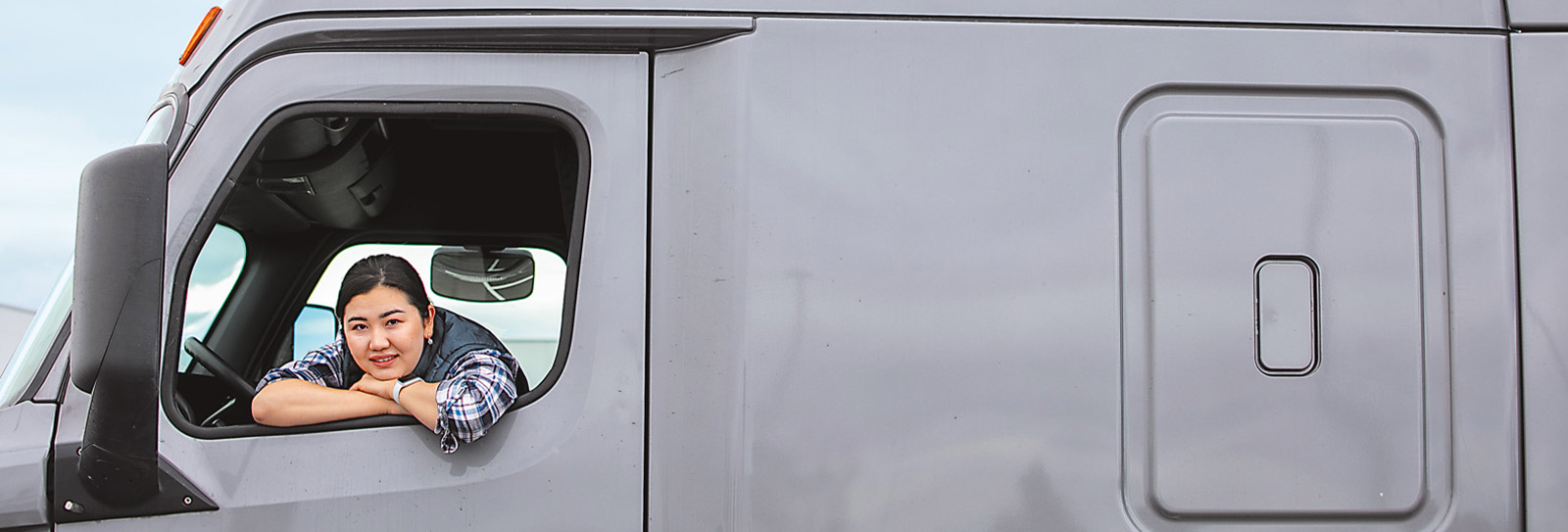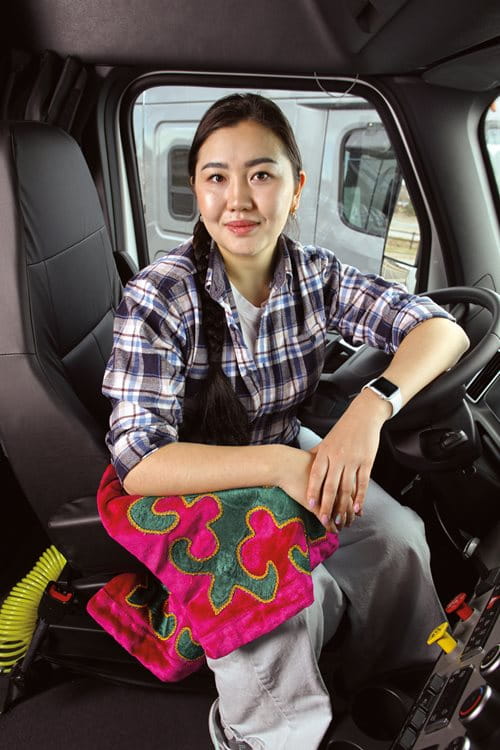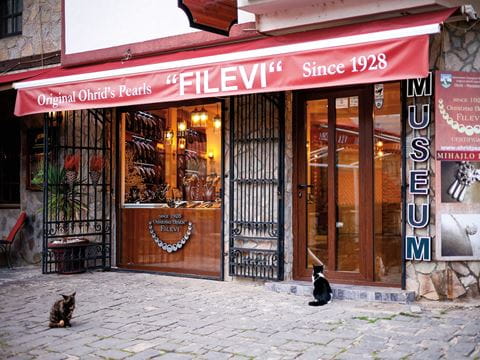
Central Asian Women Channel Nomadic Ancestors as Truckers in US
As the US trucker shortage deepens, there’s never been a better time to work behind the wheel. Joining those on the road are a growing number of women from Central Asia, where nomadism and can-do have long roots in the cultures of the Silk Roads.
Looking out at the white sands and glistening waters of the Gulf of Mexico, Arailym Mergenova remembers as a child peering westward from Aktau, Kazakhstan, to the Caspian Sea disappearing over the horizon.

“I look at it [trucking] as a spiritual way of being a nomad—seeing places, seeing people, expanding your boundaries as much as you can.”
—Aidana Tokenova, Denver, Colorado
“When I opened my door, I saw the sea every time,” she says.
As a girl in the mid-1990s, she traveled abroad with her parents to Turkey and the UK, but Hollywood stoked her imagination and expanded the boundaries of her wanderlust. “I dreamed about seeing every state in the USA.”
After graduating university with a major in economics, she landed in Panama City Beach, Florida, thanks to a US student-exchange visa often used to help tourist towns fill jobs in the summer. While the reality was less glamorous than Hollywood, the tourists were plentiful and the ocean familiar.
In 2015, after two summers working in Florida, Mergenova, by then also married, returned to Panama City Beach for good with her husband. There, while servicing hotel rooms and picking up other jobs, Mergenova saw more clearly than ever how in the US an entrepreneurial spirit could outrun an education.
Although she says her next career move was not intentional, Mergenova concedes that it may have been provoked by an unconscious inclination that complemented her immigrant hustle.
“It’s true that we were nomadic people hundreds of years ago, but everybody chooses their own reason to be a truck driver,” she says.


Left:“It’s true that we were nomadic people hundreds of years ago, but everybody chooses their own reason to be a truck driver.” —Arailym Mergenova, Panama City Beach, Florida
Right: “That’d be really good for me, and I know how to run this business.”
—Aisha Meirmanova, in Denver, Colorado, explaining her dream of using earnings from driving 18-wheelers to open a food truck serving coffee and breakfast.
At age 23, after two months of study, Mergenova passed the State of Florida’s Commercial Driver License exam.
Women truckers are rare in the US and even more so when counting those who are also immigrants. Mergenova is however part of a growing cadre from traditionally Turkic nomadic cultures of Central Asia, where the post-Soviet borders of Kazakhstan, Kyrgyzstan, Uzbekistan and Turkmenistan were largely superimposed over cultures that for thousands of years have found identity in their searches for pasture.
Some acknowledge readily how they carry this heritage across continents and behind the wheel. Aidana Tokenova, a 29-year-old trucker-in-training from Nur-Sultan, Kazakhstan, says it was when her mother didn’t stop her from seeking higher education in the US that Tokenova began to self-identify as a “free spirit.”
“There is a lot of movement that is reminiscent of nomadism that is involved in modern urbanization structures.”
—Jonathan Washington, Swarthmore College
While the main allure is the paycheck, she says, the prospect of hitting the road with her husband, untethered by rent and other obligations, hits home.
“I look at it in the spiritual way of being a nomad, seeing places, seeing people, expanding your boundaries as much as you can,” she says. “It’s all I’ve got left—my last name and my heritage, since I’m so far from home.”
For others like Mergenova, such desire to roam feels only tenuously linked to this history; it feels more like a pragmatic pursuit that seems downright American.
“There is a lot of movement that is reminiscent of nomadism that is involved in modern urbanization structures,” says Jonathan Washington, an expert on Kyrgyz language and culture at Swarthmore College in Pennsylvania. He explains that although, all across the Turkic-speaking cultures of Central Asia, lines between encampment, village and city are ever more blurred, it remains common for even the most urbane professionals to feel deeply linked by family and tradition to herding life. Bridging this gap requires a transit between cultural worlds.
![“My husband, he helps me. He’s my passenger and he’s my guide. For seven months [because of him] I haven’t received driving tickets.”
—Amina Alykulova, Cincinnati, Ohio—where both she and her husband, Adilet Ramanov, also work as professional wrestlers.](https://www.aramcoworld.com/-/media/aramco-world/articles/2022/central-asian-women-hit-the-us-road-images/image-4.jpg)
“My husband, he helps me. He’s my passenger and he’s my guide. For seven months [because of him] I haven’t received driving tickets.”
—Amina Alykulova, Cincinnati, Ohio—where both she and her husband, Adilet Ramanov, also work as professional wrestlers.
Driving, he says, can accomplish this. But for women, in Central Asia as in the US, the industry is almost exclusively a men’s club.
When she learned about truck driving from her friend Micka, who was pulling down $2,500 some weeks, Mergenova grew enchanted, but she also knew she’d face resistance. “Men think that if you’re a woman, you should sit at home,” she says. “’Where is your husband? Why can’t he do these things? You should sit home and birth babies and cook.’ Everybody talked to me like that. It’s so heavy when women start in the trucking business.”
But the sight of her friend working in a cavernous cab of an 18-wheeler instilled confidence, and Mergenova’s husband lent her his encouragement—and went on to get his license too.
Their timing couldn’t have been better: Trucking in the US is at an inflection point amid skyrocketing delivery demand. Even before the coronavirus pandemic, the rise in e-commerce was luring drivers away from long-distance, over-the-road jobs at the same time the historical labor pool of white men was shrinking, as retirements outpaced new drivers. (Still, more than three-quarters of US truck drivers are white; only eight percent are women.)
That’s changing as Punjabis, Russians, Eastern Europeans and especially Mexicans and Central Americans get behind the wheel. In 2020, foreign-born drivers made up 16.6 percent of the total, according to the Institute for Immigration Research at George Mason University; among them, women accounted for just 4.9 percent.
“People think you need to be big and burly. They think you need to be mechanically minded and you need to be away from home for days at a time, and none of that is true anymore.”
—Ellen Voie, Women in Trucking Association
Female commercial drivers, she points out, are 20 percent less likely than their male counterparts to be involved in an accident. Women drivers also accept training easily, lead with empathy and excel at many of the customer-facing aspects of the profession, she adds. Perception remains the problem.

“We’re all immigrants, so we’re here to do—to make money to provide bread for our families.”
—Ramiz Kerimov, Chicago, Illiniois
“People think you need to be big and burly. They think you need to be mechanically minded and you need to be away from home for days at a time, and none of those are true anymore,” Voie says, noting that trucks are so high tech now that drivers rarely touch the engines.
Women can also make an entire career out of what the industry calls “drop-and-hook,” in which the cargo never leaves the trailer, and short- and medium-haul jobs like transporting shipping containers and running waste-management routes: All mean that even women with children may start seeing this as a viable career, Voie says.
For Aisha Meirmanova, a 26-year-old mother of a year-old daughter, finding a local gig will be essential. The former flight attendant for Kazakhstan’s Air Astana lives a well-grounded life near Denver, where the dry air and mountains remind her of home.
Now in training, she hopes trucking will help her and her husband save for the future while not missing out on their daughter’s present. Maybe one day, she says, she’ll work a truck that stays parked most of the day: a food truck serving coffee and breakfast, a job that capitalizes on her experience serving customers in the skies.
“That’d be really good for me, and I know how to run this business,” she says.
Mergenova finds it hard to pinpoint why resistance to her work emerged back home. Turkic steppe culture had a reputation for flexibility in matters of gender-based labor. Although women generally covered the domestic realm and men generally handled herding duties, women always contributed to the family’s livelihood. And anytime a “male” task didn’t get done—like slaughtering sheep—women stepped up to complete it, Washington says.
Even as far back as the 14th century, famed Moroccan traveler Ibn Battuta noted the industry of women in Turkic lands and how they took on public-facing roles more readily than their counterparts elsewhere.
Perhaps as influential now is the experience of nearly a century under Soviet rule, which encouraged and expected women to work, says Ajar Chekirova, a Kyrgyzstan-born assistant professor of politics at Lake Forest College, just north of Chicago, who has studied immigrant livelihoods.
Especially in Chicago, long a trucking hub thanks to its location near the center of the US, Chekirova says the industry has become popular with Central Asians. Many previously worked as taxi drivers but were pushed out when Uber came along.

“’You should sit home and birth babies and cook.’ Everybody talked to me like that. It’s so heavy when women start in the trucking business. ... I’m just keeping positive.”
—Arailym Mergenova
“In any community gathering you go to, you will find people who work in the industry. It’s definitely very visible. It’s something that is discussed in social media groups that are not intended specifically for truckers. There you will see posts about hiring drivers, or hiring mechanics or technicians,” Chekirova says.
And in a new culture, women from the region are finding the doors unlocked.
“I don’t judge people for whatever their gender is,” says Ramiz Kerimov, 34, who runs N and N Transportation, a dispatching firm in Denver. “For me, the most important is communication.”
Of N and N Transportation’s 42 trucks, seven of which are company owned and 35 driven by owner-operators, only three are driven by women from Central Asia.
Kerimov arrived in the US in 2002 from Turkmenistan as a high schooler with his mother. He later dropped out of business school, was recruited to driving by a friend, quit after the first month, but then he returned to it, drawn by the prospect of the solid earnings. He bought a 2006 Freightliner Century with $3,000 down. But his experience on the road was decidedly unromantic.
“I felt like it’s a dog’s life. You’re always in a box,” he says.
Dispatching—finding loads for owner-operators and managing back-office tasks like registration, accounting, safety compliance and cargo logs became his calling, which enabled Kerimov to participate in the industry without being away all the time.
“Trucking does sometimes divorce people,” he says. “I want my son to see there is a dad next to him.”
“In any [Chicago] community gathering you go to, you will find people who work in the industry.”
—Ajar Chekirova, Lake Forest College

“At first it was lonely for me, but you get used to it as time goes on, and you start to socialize with other female truckers.”
—Albina Bekicheva, Chicago
Mergenova, however, embraced the lifestyle from the first mile. While waiting on a load, she says, she’d often forgo a ho-hum truck stop and find instead a nearby Walmart—where she’d hit the nail salon and touch up her makeup. “People were always asking, ‘Why are you doing your eyelashes? Nobody’s seeing you in the truck.’ I’d say, ‘Are you kidding? I’m doing it for myself, not for somebody else. I need to feel like my real self.’”
Along the way, she also fulfilled her bucket-list dream of traveling to all 48 contiguous US states, and she used the downtime to plan, listen to audiobooks and paint. Two years in, she and her husband bought their own trucks. Blending her loves of travel and photography, she posted bright, color-coordinated photos of herself and her experiences on Instagram and amassed more than 75,000 followers. In February 2020, Kazakh website BaigeNews ran an article about her titled “Trucker Lady.” A few criticisms followed, but to her the important comments came from women who said she’d become an inspiration.
Mergenova also found a source of encouragement along the way: Elnura Moldokadyrova, a former television journalist from Kyrgyzstan who now counts more than 201,000 followers on her YouTube channel, Kyrgyzka v amerike (Kyrgyz girl in America).
Moldokadyrova’s forays into social media—and, later, trucking—started in 2017 when she and her husband, Renat Shamudinov, moved to Chicago. With only basic skills in English but many connections in the Kyrgyz community, she recalls rejections from 15 restaurant jobs. She began driving for DoorDash and Uber Eats and did this for a year before discovering free English courses and conversation partners on YouTube.
Educated as a journalist, she also began profiling the lives of Russian- and Kyrgyz-speaking immigrants. Among her most-popular posts were videos of women truck drivers.

“When you’re out on the road by yourself, you encounter a lot of different situations—anything can happen, and it was interesting to show people how that happens.”
—Elnura Moldokadyrova, Chicago
A friend seeking to create his own trucking venture took note of Moldokadyrova’s social media prowess and approached her and Shamudinov about a partnership. With their help, in a matter of months, he recruited 30 drivers.
Eventually, Moldokadyrova and Shamudinov decided to start their own trucking outfit, and between Uber fares Moldokadyrova studied for the written CDL exam to join her husband as a driver.
However, she soon found success at something she enjoyed more: She now works as a full-time social media influencer. But she remains connected to her fellow women behind the wheel via a WhatsApp group where more than 70 female drivers from Central Asia continue to share experiences, advice and camaraderie.
One member of the group, Albina Bekicheva, 34, joined after arriving from Kazakhstan three years ago. With the support of the online community, Bekicheva started driver training and, license in hand, settled into driving.
“At first it was lonely for me, but you get used to it as time goes on, and you also start to socialize with other female truckers. We call each other on the phone a lot,” Bekicheva says. The conversations veer from practical, like pointers on replacing tire treads, to personal. Apps like Zenly and Live360 facilitate in-person meetups in cities across the country.
Bekicheva plans to start her own business one day, but for now, she is content driving for the aptly named company Modern Nomad, Inc., which is run by Shamudinov.
For Mergenova’s part, driving has become easier, now that she owns her white 2015 Freightliner Cascadia and can pick and choose routes that—ideally—lead from one clean, well-lit warehouse to another. With so many companies clamoring for drivers, job security feels high.
But other roads, too, beckon. At home in Florida, as she prepares to hang up from a phone interview, ambient cooing from her infant daughter fills the room.
Now 29, she says she’s ready to get back to driving, confident that she’ll find a balance between work and family.
“I try to only remember the good things throughout the day, like a smile, when someone opens a door for me, or when someone gave me a compliment,” she says. “When you pay attention to the happy things, happy things have a way of pulling you in.”
About the Author

Bear Gutierrez
Bear Gutierrez is a Pulitzer Prize-winning photojournalist and commercial photographer based in Denver. After 10 years on staff at the Rocky Mountain News, he is now also a frequent volunteer mentor for aspiring journalists.
J. Trevor Williams
J. Trevor Williams is a global business journalist based in Atlanta where he serves as publisher of the online international news site, Global Atlanta (globalatlanta.com). Follow him on Twitter @jtrevorwilliams.
You may also be interested in...

Family Secret: The Mystery of North Macedonia’s Ohrid Pearls
Arts
Artisans are preserving the elusive technique behind these pearls—handmade from a fish, not an oyster—in a town of Slavic, Byzantine and Ottomon influences.
Preserving the Imaret of Kavala: Safeguarding an Ottoman Landmark
Culture
Preservation efforts have protected the historical design and cultural legacy of the Ali Pasha-gifted Imaret of Kavala—one of most important Ottoman landmarks in Greece.
Cartier and Islamic Design’s Enduring Influence
Arts
For generations Cartier looked to the patterns, colors and shapes of the Islamic world to create striking jewelry.